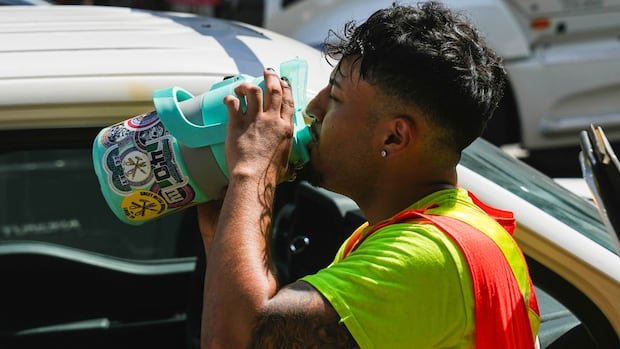As a heatwave sweeps through Ontario, Quebec, and several U.S. cities in June, medical professionals are advising individuals to be cautious in the potentially dangerous weather conditions.
A significant portion of Eastern Canada is currently experiencing extreme heat and high humidity levels. Meteorologist Matt Grinter from the Weather Network in Oakville, Ont., reported that Toronto’s Pearson airport set a new humidex record for June on Sunday, with temperatures feeling as high as 46.3 degrees Celsius. This heatwave is anticipated to persist for three days.
In the summer of 2021 in British Columbia, a total of 619 deaths were linked to a heat event, as outlined in a B.C. coroner’s report. The deceased individuals often had underlying health issues, including conditions such as schizophrenia, depression, substance use disorders, diabetes, heart disease, and respiratory ailments.
Edward Xie, an emergency physician at Toronto’s University Health Network, highlighted that health authorities, physicians, and nurses pay particular attention to temperatures above 26 degrees Celsius. Based on the B.C. incident, it was found that the highest risk of fatality was associated with indoor temperatures surpassing this level during the heatwave.
Experts like Xie emphasize the impact of heat on the body and offer recommendations to ensure safety. Symptoms of heat exhaustion include warm skin, flushed appearance, increased heart rate, elevated breathing, dizziness, headaches, and thirst, affecting anyone exposed to high temperatures. It is crucial to cool down within half an hour when such symptoms manifest.
Heat stroke, characterized by a core body temperature exceeding 40.6 degrees Celsius, poses severe health risks, potentially leading to organ damage and even death. Symptoms of heat stroke include rapid breathing, confusion, seizures, and nausea, necessitating immediate medical attention.
To prevent overheating, experts advise taking measures such as seeking shade indoors, wearing light-colored clothing, donning hats, covering up, and scheduling physical activities during cooler morning or evening hours. Staying hydrated, using cool water-soaked towels if air conditioning is unavailable, and taking refreshing showers or baths can help manage overheating.
Sweating plays a vital role in regulating body temperature, allowing heat dissipation. However, in humid conditions, sweat evaporation is hindered, reducing its cooling effectiveness. Certain groups like babies, pregnant individuals, and seniors above 65 may have reduced sweat production efficiency. Medical conditions and some medications can further compromise the body’s ability to sweat, emphasizing the importance of staying hydrated during heatwaves.
Individuals taking medications like diuretics or those managing high blood pressure are at risk of complications in extreme heat due to blood pressure fluctuations and fluid loss. It is essential to consult healthcare providers before modifying medication use. Adjusting movement patterns, like avoiding rapid transitions, can help mitigate the combined impact of heat and medications on the body.
Sun sensitivity can be heightened by certain medications, increasing the risk of sunburn. Sunscreen application, wearing protective clothing, and avoiding prolonged sun exposure are recommended to prevent skin damage. Proper medication storage is crucial in preventing efficacy issues, especially for heat-sensitive medications like insulin or epinephrine injections.
By being mindful of their body’s signals, staying hydrated, and adjusting activities to suit the weather conditions, individuals can better protect themselves from the adverse effects of extreme heat.

